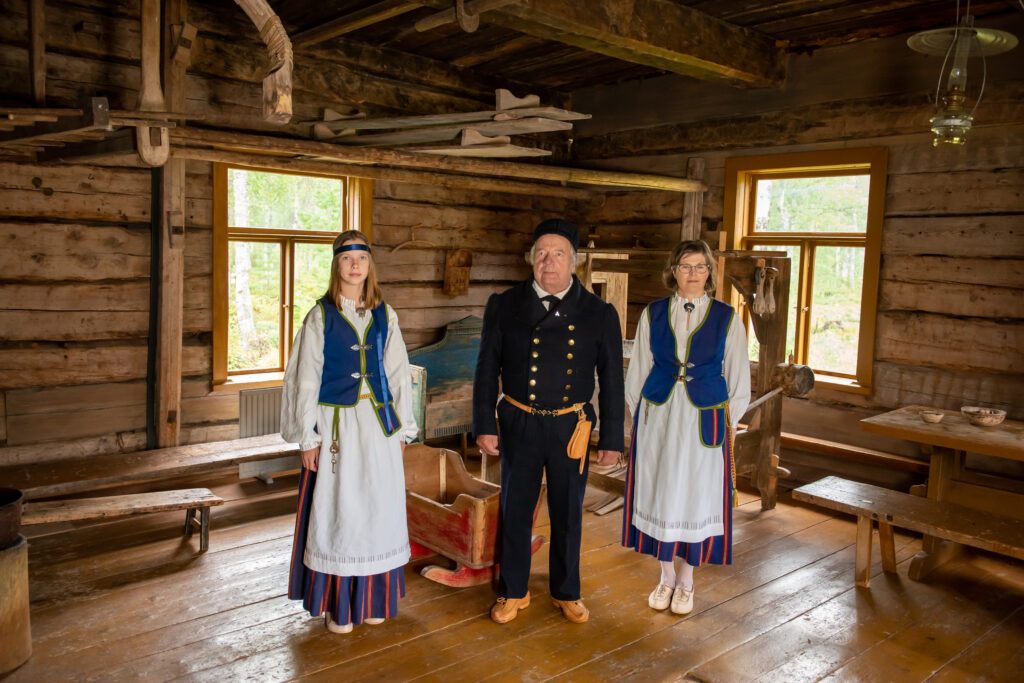Koillismaa has both a woman’s and a man’s folk costume. The folk costume of Koillismaa has been designed as a festive costume for women and men in all the municipalities of Koillismaa (Kuusamo, Taivalkoski, Pudasjärvi and Posio).
Like the Sámi people, bright colours were used in clothing in the region. The woman’s costume represents the era of the end of the 19th century and the man’s costume the 18th century. According to the estate inventory deeds, the folk costume culture of the Koillismaa region was rich and varied. It includes features of old-fashioned clothing, but also reflects fashion.
Koillismaa women’s folk costume
Skirt
The skirt is pleated from blue-based red-green-white striped twill fabric. The waistband is skirt fabric.
Apron
The hem of the apron has the same stem stitch decoration as the collar and cuffs of the shirt. The fabric is linen or cotton-shine thread fabric.
Belt pocket
The pocket made of skirt fabric has one group of stripes in the middle and a narrow light green twill band surrounds the pocket. The pocket is attached to the waist with a string with a gathered rolling pattern. The base colour of the string is yellow, the dovetail pattern in the middle is red and the edge pattern is blue and yellow.
Bodice
The bodice is quite long and made of a single-coloured wool fabric matching the blue stripe of the skirt. The bodice is bordered by a green twill stripe. There are two hook-and-loop fasteners.
Röijy, or coat
The straight, frieze coat is either off-white or red. The front edge and neckline have the same dovetail patterned string as the belt pocket.
Headdress
The headdress of an adult woman is a French hood covered with dark blue silk. The lace of the hood is tulle. Instead of a hood, the girls wear dark blue ribbons similar to the pocket string. When tied around the head, the ribbon reaches the waist or the bottom of the bodice.
Jewel
The jewellery is the chest buckle that closes the slit of the shirt necks and the leaf clasps of the bodice. The costume includes a key and a key hook.
Socks
Socks are white linen or cotton socks in summer and off-white or grey wool socks in winter.
Footwear
The footwear is black lace-up shoes with a half-high heel, black ankle boots, black open-toed or buckled shoes, natural-coloured kurpponen, i.e., slip-ons, or natural-coloured lace-up boots.
Koillismaa men’s folk costume
Shirt
The shirt is a white linen or semi-linen shirt modelled after a traditional festive shirt. The collar is supported with a scarf.
Scarf
Around the neck is a silk or blue-white-striped or blue-red-striped cotton scarf or scarf. The scarf is folded, tied and the shirt collars are pulled over the scarf so that the corners of the scarf hang down.
Pants
The pants are long and have a narrow hatch in the front. The fabric is dark blue frieze. The upper edge of the front piece is notched. The pants have side pockets. The legs are pushed into the boot leg and the strings are wrapped around the boot leg.
Röijy
Röijy is of the same frieze as the pants. It has a wide and folded collar, a double-breasted buttoning and vest pockets. The buttons are self-supporting and made of brass. Röijy is buttoned because there is no vest in the suit. In the summer, one can wear a blue-and-white-striped semi-wool blouse with the costume instead of röijy.
Headdress
The headdress is a patalakki or skull cap, a long cap, which is made of black velvet or broadcloth.
Sheath belt
The belt is leather and has brass links strung on it. On the left hip there is a sheath knife hung on a light ring and a cigarette bag with a pipe cleaner and a bottle of pitch oil in its leather case.
Kauhtana
The suit is complemented by a grey or white frieze kauhtana, i.e., cape. Kauhtana is a long, loose overcoat with red lace decoration. The kauhtana is belted with a homemade red-black wool belt, a belt or a striped kalminki belt.
Socks
The socks are black or dark blue, plain knit and wool.
Footwear
The footwear is lace-up boots according to the local model, the boot legs of which are tied to fit the calves with strings with a gathered rolling pattern, e.g., paula or black laced shoes.
The costume has no vest. The vest was not part of the Koillismaa costume until the end of the 18th century. Only some men in Pudasjärvi had striped vests. Instead of vests, men in Koillismaa could have several shirt fronts.
